National Parks In Pennsylvania – What to See
Pennsylvania is an important place when it comes to the history of the United States. It’s where the Declaration of Independence and the US Constitution were drafted. It’s also home to General Washington’s Headquarters in Valley Forge, and the site of the Battle of Gettysburg which later inspired the Gettysburg address.
But there’s more to Pennsylvania than just history. The state also features a number of recreation areas, watersheds, and scenic rivers.
There are no National Parks in Pennsylvania. However, there are 23 National Park affiliated sites and 6 National Trails in the state.
National Park Affiliated Sites In Pennsylvania
- Allegheny Portage Railroad National Historic Site
- Chesapeake Bay Watershed
- Delaware & Lehigh National Heritage Corridor
- Delaware Water Gap National Recreation Area
- Edgar Allen Poe National Historic Site
- Eisenhower National Historic Site
- First State National Historical Park
- Flight 93 National Memorial
- Fort Necessity National Battlefield
- Friendship Hill National Historic Site
- Gettysburg National Military Park
- Gloria Dei Church National Historic Site
- Hopewell Furnace National Historic Site
- Independence National Historical Park
- Johnstown Flood National Memorial
- Lower Delaware National Wild And Scenic River
- Oil Region National Heritage Area
- Rivers Of Steel National Heritage Area
- Schuylkill River Valley National Heritage Area
- Steamtown National Historic Site
- Thaddeus Kosciuszko National Memorial
- Upper Delaware Scenic & Recreational River
- Valley Forge National Historic Park
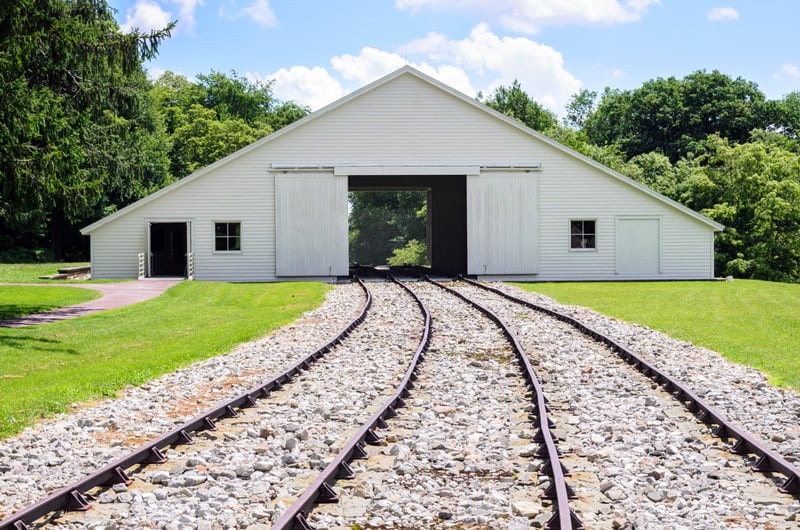
Allegheny Portage Railroad National Historic Site
Railroad buffs will love the Allegheny Portage Railroad National Historic Site in southwestern Pennsylvania. This site was where the first railroad bypassed the Allegheny Mountains and offers many attractions on its spacious 1249 acres.
Engine House #6 is a replica of an original building for storing steam engines of the time.
It’s also the home of the first railroad tunnel in the US. Men worked 12 hours a day, 6 days a week, often in harsh conditions, to build the Staple Bend tunnel. This site also features the Lemon House, which included a tavern. It was constructed in the 1830s and has been restored to its original luster.
Chesapeake Bay Watershed
The Chesapeake Bay Watershed covers 64,000 square miles, making it the largest estuary (where fresh and saltwater mix) in the U.S. In a 2009 Executive Order, President Obama named it a “national treasure.”
The bay is a sportsman’s paradise with trophy sport fishing and waterfowl hunting. If you love watersports like kayaking, tubing and wakeboarding, the Chesapeake Bay Watershed is the place for you.
If you are more of a land lover, you will certainly enjoy the hiking, biking, and horseback riding. Walk the land previously inhabited by Native Americans and early colonial settlers. There are even geocaching opportunities along the rivers.
Delaware & Lehigh National Heritage Corridor
The Delaware & Lehigh National Corridor stretches through five eastern Pennsylvania counties. This region is where the Lehigh and Susquehanna and Lehigh Valley railroads traveled. But long before the railroads came to the area, Native Americans traveled this region for its trading routes.
The corridor also includes the Lehigh and Delaware Canals, solidifying it as an important area of America’s industrial age. There are 12 parks with over 100,000 acres of land to explore. The National Canal Museum, located on the D&L Trail, features an exhibit that highlight the industrial age as well as the Locktender’s House and canal boat rides.
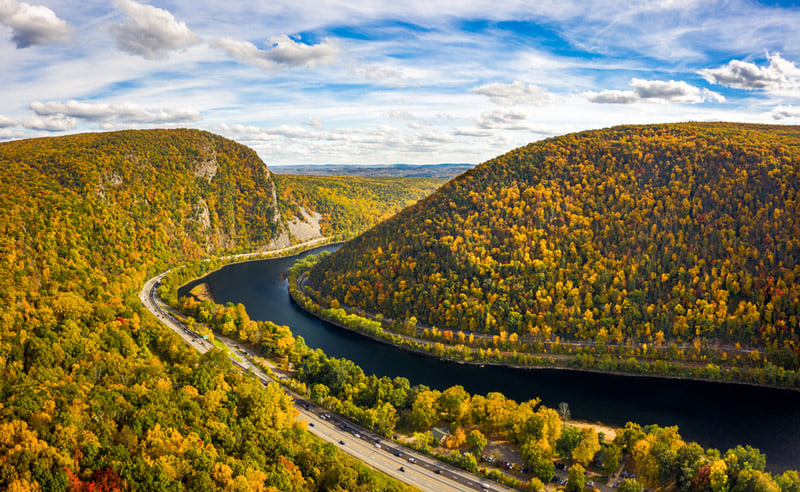
Delaware Water Gap National Recreation Area
If you love the great outdoors, you won’t want to miss the Delaware Water Gap National Recreation Area. Included in the 67,000 acres covered by the park is 40 miles of the Middle Delaware National Scenic and Recreational River.
There is also plenty of wildlife to observe, over 100 miles of hiking trails, and colonial villages and structures to explore. The beauty of the Delaware Water Gap has thrilled visitors for hundreds of years
Visit the Millbrook Village to learn what it was like to live in the late 19th century. The Foster-Armstrong House and Nelden-Robert Stonehouse goes back even further, with relics from the 1700s.
Edgar Allen Poe National Historic Site
American author Edgar Allen Poe lived in Pennsylvania for almost six years with his wife and mother-in-law. During his time in this Philadelphia home, Poe wrote what many consider to be the first detective novel, “The Murders at the Rue Morgue.”
The Edgar Allen Poe National Historic Site is located about a mile from the Liberty Bell Center and Independence Hall and open to visitors. You may take a self-guided tour or rangers are available for guided tours. Much of the home remains unfurnished, but there are exhibits and a Reading Room, which features books and CD readings of Poe’s tales.
Eisenhower National Historic Site
The farm of Dwight Eisenhower, World War II General and the 34th President, is located near the Gettysburg battlefield. This farm became a retreat from the White House for the president and his first lady, Mamie, and even hosted meetings for world leaders.
At the Eisenhower National Historic Site you can tour the home, barns, and cattle operation as well as the walk the grounds. The 4,100 square foot home contains almost 100% of its original furnishings.
You may take a self-guided, audio, or guided tour. As you walk the grounds, look for red-tailed hawks, blue herons, and red foxes that were guaranteed a safe habitat by the president himself.
First State National Historical Park
First State National Historical Park extends into Pennsylvania at Chadds Ford, home of artists Andrew, Jamie, and N.C. Wyeth. First State National Historical Park is actually seven separate sites including the Brandywine Valley, Fort Christina, Old Swedes Historic Site, New Castle, The Green, Dover, John Dickinson Plantation, and Ryves Holt House.
Whether you are a history buff or nature lover, the First State National Historical Park has something for everyone. There are hiking trails with picnic tables, horseback riding, and kayaking sites.
For history lovers, there historic homes, plantations, and churches open to the public. Children can sign up to become Junior Rangers.
Flight 93 National Memorial
9/11 was a dark time in American history, but the heroic people aboard United Airlines Flight 93 did all they could to overtake the terrorist hijackers. The Flight 93 National Memorial honors those people and gives us a place to remember the events of that day.
A Boeing 757 crashed into a field near Shanksville, ultimately preventing it from flying into the U.S. Capitol. The Wall of Names includes forty white marble panels, each engraved with the name of a passenger or crew members on Flight 93. There are benches available that face the wall and crash area allowing for time to reflect.
Visitors may leave messages behind or read those left by others. The visitor center features an exhibit the recounts the flight in greater detail.
Fort Necessity National Battlefield
The Fort Necessity National Battlefield may not sound familiar to many, but it was the opening battle of the French and Indian War in 1754. The French and Indian War was a conflict between English troops, French troops and Native Americans.
Until this point, the French had a stronghold in North America. After this war, that stronghold was removed, setting the stage for the American Revolution.
This battle was also a young George Washington’s first military experience. There is day-hiking available during summer months and cross-country skiing in the winter. Outdoor exhibits walk you through the Braddock Campaign of 1755.
Friendship Hill National Historic Site
Statesman Albert Gallatin lived in the home on the Friendship Hill National Historic Site, located about 50 miles south of Pittsburgh. Gallatin served as the U.S. Secretary of Treasury under both Thomas Jefferson and James Madison.
Among his accomplishments while in office was the acquisition of the Louisiana Purchase and the funding of the Lewis & Clark exploration of that territory. After his tenure as the Secretary of Treasury, he became an Ambassador to France. The restored home chronicles the life of Gallatin with exhibits and an audio tour.
There are also ten miles of nature trails to explore in the area.
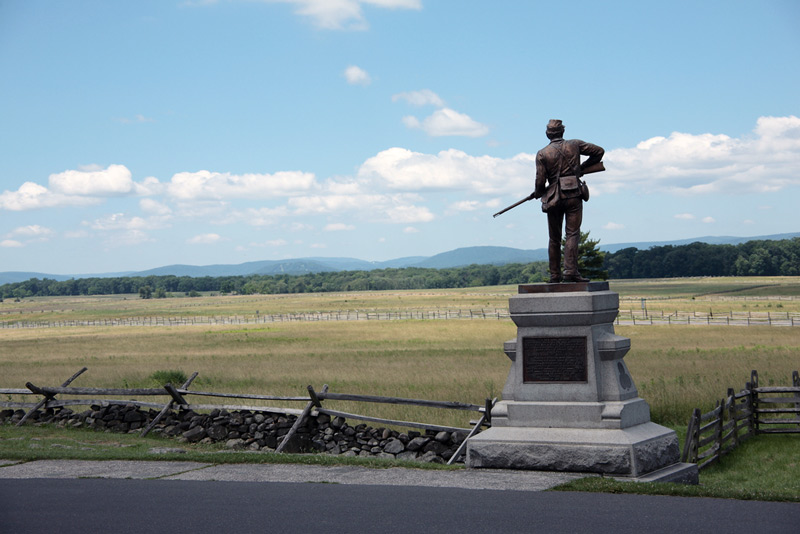
Gettysburg National Military Park
Gettysburg was the home of one of the most famous civil war battles – and inspiration for President Lincoln’s Gettysburg Address. Today, you can walk the same battlefield soldiers fought on in 1863 in the Gettysburg National Military Park.
Between April and October, you will find Civil War experts throughout the site, offering historical accounts while demonstrating tools and firepower used in battle.
The Gettysburg National Military Park Museum and Visitor Center immerses you in the era with guided talking tours of the battlefield and a look at the Gettysburg Cyclorama, a 337-foot painting of the battle done by French artist Paul Philippoteaux that brings the battle to life.
Gloria Dei Church National Historic Site
The Gloria Dei Church National Historic Site houses the oldest church in Pennsylvania, having been built in the late 1600. It is also the second oldest Swedish church in the U.S. and still has an active congregation today.
Visitors are welcome Tuesday-Sunday from 9 am until 4 pm. You can find models of the Dutch ships Fogel Grip and Kalmar Nyckel hanging from the church’s ceiling. There is also a carving of the angel Gabriel, a bronze church bell that dates back to 1806, and the original baptismal font.
The nearby cemetery is where many of Washington’s army was buried along with naturalist Alexander Wilson and painter James Peale.
Hopewell Furnace National Historic Site
The Hopewell Furnace National Historic Site is located in the Schuylkill River Valley Heritage Area. The Hopewell Plantation was part of the American Industrial age, producing iron between 1771 and 1883.
A self-guided tour of the area allows you to explore museum exhibits throughout the furnace community. Structures such as the blast furnace, water wheel, machinery, and cast house have been restored to what they looked like in the early 19th century.
Also included on the land is the Ironmaster’s mansion, farm, Bethesda Church, orchards, mines, and the office/store where workers could make purchases. Step back in time to learn what it was like to live in an all-inclusive 19th century community.
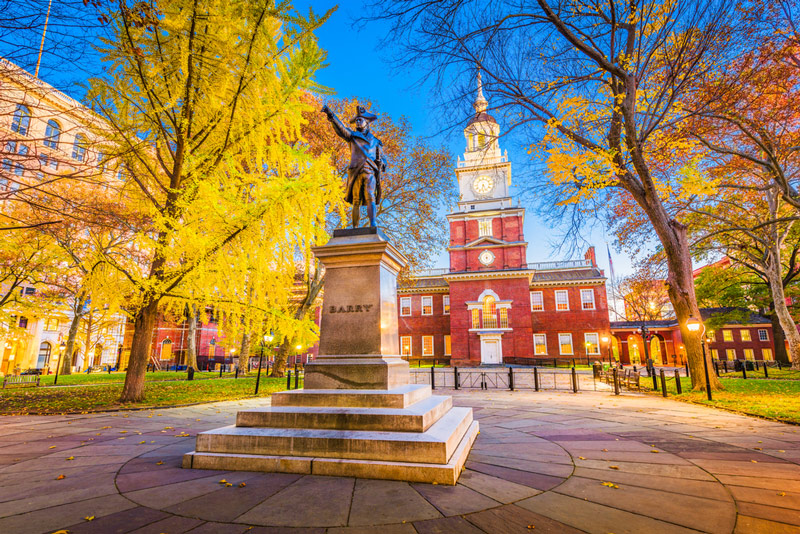
Independence National Historical Park
Want to step into a piece of living history? The Independence National Historical Park includes sites that celebrate the birth of America, including Independence Hall, where both the Declaration of Independence and U.S. Constitution were signed by our founding fathers.
In this park you can also see the Liberty Bell, which continues to be a symbol of freedom and the fight for equality. Visit Congress Hall, where the U.S. Congress met between 1789 and 1800.
Art lovers can see over 150 portraits of politicians, military leaders, explorers, and scientists in the Portrait Gallery in the Second Bank of the United States.
Johnstown Flood National Memorial
The Jamestown Flood was an American disaster that happened on May 31, 1889. The South Fork dam failed, releasing 20,000,000 tons of water on the townspeople of Jamestown, PA. While 2,209 were killed (only slightly fewer than were killed on 9/11), it did bring the country together to help support those that survived the flood.
The Lake View Visitor Center has an exhibit that walks you through the timeline of the flood, an event which came to be known as Black Friday. You can also visit the 16 cottages built along the shores of Lake Conemaugh by members of the South Fork Fishing and Hunting Club in the late 1800s.
Lower Delaware National Wild And Scenic River
The Lower Delaware National Wild and Scenic River is both picturesque and historical. Washington Crossing Historic Park is where Revolutionary War General George Washington crossed the Delaware River to march to Trenton and re-ignite the fight for America’s freedom.
The canals of this area provided transportation for various goods in the early 19th century. This region is also the home of a yearly Sojourn, a week-long trip down the river by participants in canoes and kayaks.
If you love hiking, boating, fishing, swimming, canoeing, and camping, check out the Tinicum Park, Ralph Stover State Park, or the Tohickon Valley Park.
Oil Region National Heritage Area
The Oil Region National Heritage Area celebrates the first successful commercial oil well drilling by Edwin Drake in 1858. Because of that, this region is known as the Birthplace of the Petroleum Industry.
Outdoor recreation includes hiking, biking, and exploring the picturesque countryside. You can enjoy the scenery of the area from a vintage Pullman train on the OC&T Railroad excursion train.
Looking for somewhere to stay? Check out the Caboose Motel right off the tracks. Oil Creek State Park has Plum Dungeon Falls with its 60-foot waterfall drop. The Dennison Point Overlook offers a beautiful view from 980 feet above the Kennerdell Tract of the Clear Creek State Forest.
Rivers of Steel National Heritage Area
The Rivers of Steel National Heritage Area tells the story of the area’s effect on the Age of Steel and covers eight counties in southwestern Pennsylvania. Natural resources of the area allowed for glassmaking, iron production, and coal mining.
Sites to see include the Carrie Blast Furnaces National Historic Landmark, the Bost Building National Historic Landmark, the Pump House in Munhall, and the W.A. Young & Sons Foundry and Machine Shop National Historic Landmark.
Fort Necessity National Battlefield, where George Washington had his first military fight, is also located in this region. You’ll also be able to see the Friendship Hill National Historic Site featuring the home of Congressman and later Ambassador to France, Albert Gallatin.
Schuylkill River Valley National Heritage Area
The Schuylkill River Valley National Heritage Area was designated as a National Heritage Area in 2000 for its cultural historical, and industrial influence. Both the Germans and Dutch settled in this area early on – learn about their influence on the culture in the East Penn Valley of Berks County.
Known as Coal Country, this area helped drive the American Industrial Revolution. The Hopewell Furnace National Historic Site is the home of Hopewell Plantation that produced iron from 1771 to 1883.
You can explore the Blacksmith Shop where nail, hooks, and tools were made, the schoolhouse from 1837, and Office/Store, where employees of the area could shop.
Steamtown National Historic Site
Train lovers will revel in all that Steamtown National Historic Site has to offer! There are several different types of train rides available. The Scranton Limited is a short, 30-minute ride that takes you through the railyards, across the Lackawanna River, by the Radisson at Lackawanna Station hotel, and to the University of Scranton before returning to Steamtown.
You can ride in a caboose within the park on the Caboose Experience train. Longer excursion train rides are available during certain seasons. The History Museum tells what it was like to live on the railroads as a worker while the Technology Museum explores the technology of steam railroading.
Thaddeus Kosciuszko National Memorial
You may have never heard of Polish freedom fighter Thaddeus Kosciuszko, but Thomas Jefferson called him, “As pure a son of liberty, as I have ever known…” Kosciuszko was sympathetic to the America’s cry for freedom and sailed from Poland to join the Continental Army.
The Thaddeus Kosciuszko National Memorial celebrates the life of this military engineer and statesman throughout his home. While living here, he was visited by many leaders of the day including Thomas Jefferson, William Paterson, and even Native American chiefs Little Turtle and Joseph Brant.
This memorial has exhibits that covers Kosciuszko’s military career in both Poland and America.
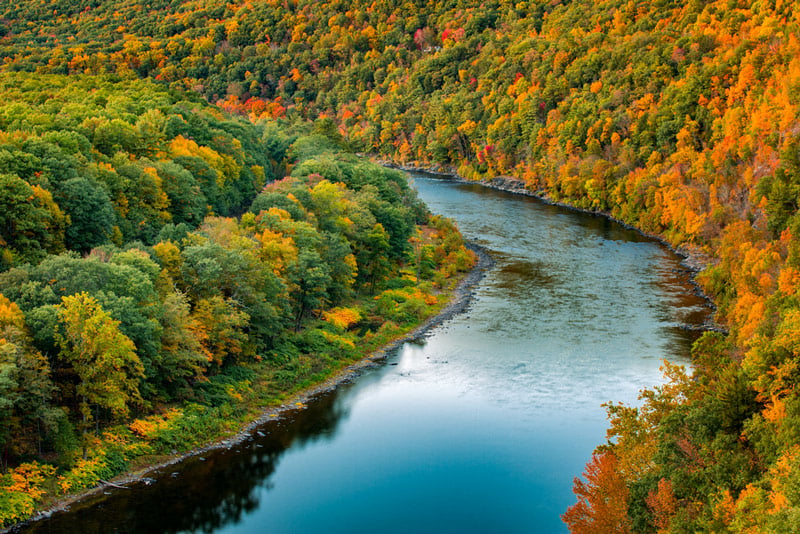
Upper Delaware Scenic & Recreational River
If you are looking to get away and enjoy some peace and quiet amidst scenic landscapes, look no further than the Upper Delaware Scenic & Recreational River.
This region has more than 14,000 acres where the waters are clear and often, bald eagles can be seen flying overhead. Recreation opportunities include boating, fishing and hiking. You may also want to drive the Hawk’s Nest, nine miles of picturesque highway that overlooks the Delaware River Valley.
Soak in the local culture and history by visiting the country’s oldest existing wire cable bridge or the museum home of western novelist Zane Grey.
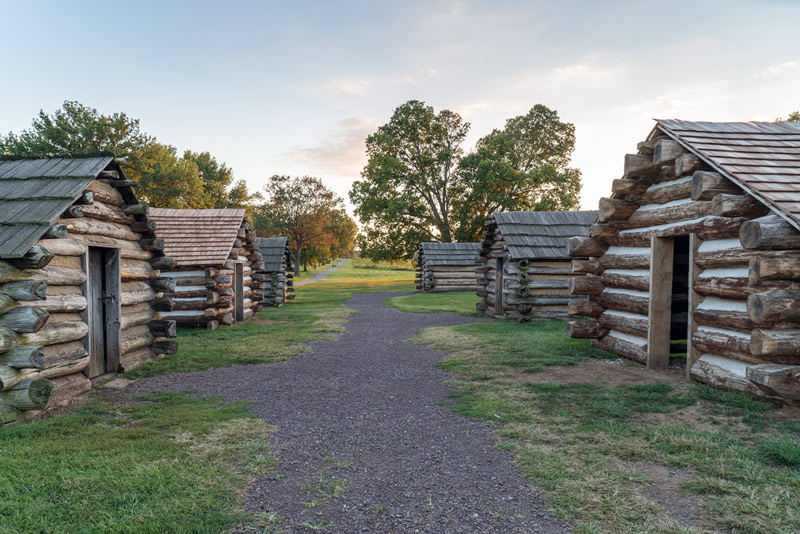
Valley Forge National Historic Park
One of the most famous historical sites in this Pennsylvania region is Valley Forge. This famous encampment of the Continental Army offers both beautiful landscapes and historic structures such as the Muhlenberg Brigade Huts, General George Washington’s Headquarters, and the Washington Memorial Chapel.
Throughout the park, you’ll find statues and monuments including the National Memorial Arch to commemorate the Continental Army’s entry into Valley Forge. The Patriots of African Descent Monument stands to honor African American soldiers who fought at Valley Forge.
Because of the vast area Valley Forge covers (3,500 acres), you may want to listen to the audio tour while driving from site to site.
National Trails In Pennsylvania
- Appalachian National Scenic Trail
- Captain John Smith Chesapeake National Historic Trail
- Lewis & Clark National Historic Trail
- North Country National Scenic Trail
- Potomac Heritage National Scenic Trail
- Washington-Rochambeau Revolutionary Route

This Post Has 0 Comments